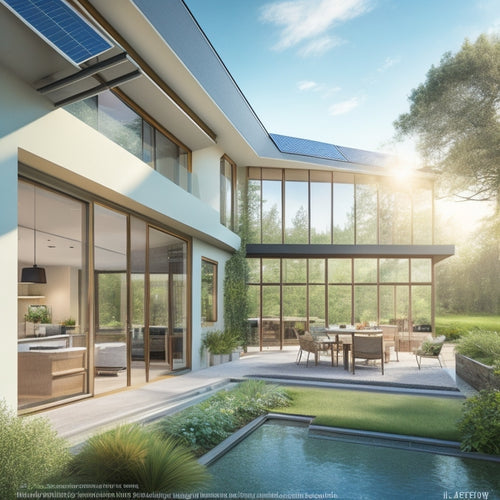
Energy-Saving Home Projects: Beginner's Guide to Efficiency
Share
As you initiate your energy-saving home projects, you'll want to focus on key areas like renewable energy, home energy audits, insulation, air sealing, and energy-efficient windows. Consider purchasing renewable energy certificates to offset your energy consumption and reduce your carbon footprint. Conduct a DIY energy audit to identify areas of heat loss and drafts, and implement simple fixes like sealing air leaks and upgrading to energy-efficient windows. By understanding carbon offset benefits and utilizing natural lighting designs, you'll be well on your way to creating a more sustainable and cost-effective living space - and there's more to investigate.
Key Takeaways
- Invest in Renewable Energy Certificates (RECs) to offset energy consumption and reduce your carbon footprint.
- Conduct a DIY energy audit to identify heat loss, drafts, and inefficient lighting in your home.
- Seal air leaks and gaps with caulk, spray foam, or weatherstripping to minimize heat loss and enhance energy efficiency.
- Upgrade to energy-efficient windows with low-E coatings and consider smart home automation for optimized temperature control.
- Harness natural lighting by strategically placing windows, installing skylights, and incorporating mirrors for light reflection.
Renewable Energy Certificates Explained
In the pursuit of a more sustainable future, you're likely to come across Renewable Energy Certificates (RECs) as a viable option to offset your energy consumption. RECs represent the environmental attributes of one megawatt-hour of renewable energy, making them a significant tool for individuals and businesses looking to reduce their carbon footprint.
By purchasing RECs, you're fundamentally buying the rights to claim that you've used renewable energy. Additionally, RECs guarantee energy from renewable sources, ensuring low-carbon operations and supporting the shift to renewable energy grid resilience.
The certificate benefits are twofold: you're supporting the development of renewable energy projects, and you're offsetting your own energy consumption. This approach allows you to compensate for the emissions produced by your energy usage, promoting a cleaner and more sustainable environment.
Understanding Carbon Offset Benefits
One major advantage of carbon offsetting is that it allows individuals and businesses to compensate for their greenhouse gas emissions, effectively neutralizing their carbon footprint.
By investing in projects that reduce greenhouse gas emissions elsewhere, you can balance out your own emissions, promoting sustainability practices.
Additionally, adopting energy-efficient practices, such as off-peak charging, can also help reduce your carbon footprint.
This process not only helps the environment but also supports projects that create jobs, stimulate local economies, and improve air quality.
You can offset emissions from daily activities like driving, flying, or energy consumption, giving you more control over your environmental impact.
Easy DIY Energy Audits
Five key areas in your home - lighting, insulation, windows, appliances, and heating/cooling systems - account for the majority of energy consumption. To identify areas for improvement, you can conduct a DIY energy audit. Start by walking through your home and noting areas of heat loss, drafts, and inefficient lighting. Use a home energy checklist to guide your assessment.
| Area | Energy Consumption Metrics | Action Items |
|---|---|---|
| Lighting | Bulb wattage, lumens per watt | Replace incandescent bulbs with LEDs |
| Insulation | R-value, energy loss | Add insulation to attic, walls, and floors |
| Windows | U-factor, solar heat gain | Install energy-efficient windows or apply window film |
Sealing Air Leaks and Gaps
As you've identified areas of heat loss during your DIY energy audit, it's time to tackle one of the most critical energy-wasting culprits: air leaks and gaps.
Air sealing is a simple yet effective way to reduce heat loss and save energy, much like how fast charging stations can recharge up to 80% in under 30 minutes, minimizing driver downtime.
Start by using draft detection methods like holding a lit candle or incense stick near potential leak sites, and don't forget to weigh the benefits of solar-powered charging solutions. You'll notice the flame flicker or smoke move towards the gap.
Common areas to check include electrical outlets, switches, windows, doors, and any gaps around pipes or vents. Use caulk, spray foam, or weatherstripping to seal these gaps.
Upgrading to Energy-Efficient Windows
The windows in your home are a significant contributor to heat loss, especially if they're old or inefficient. Upgrading to energy-efficient windows can make a substantial difference in your energy savings.
When selecting new windows, consider the window frame materials – vinyl, aluminum, or fiberglass – as each has its benefits and drawbacks. Vinyl frames are generally the most energy-efficient, while aluminum frames are more durable.
Additionally, many businesses are now adopting solar panel kits to reduce their carbon footprint and operational costs. By doing so, they showcase their commitment to environmental responsibility and increase their profitability.
Look for energy-efficient coatings, such as low-E coatings, which can reduce heat transfer and minimize energy loss. These coatings can be applied to the glass surface or incorporated into the glass itself.
Smart Home Automation for Savings
One of the most effective ways to reduce energy consumption in your home is by leveraging smart home automation. By investing in smart thermostats, you can enjoy benefits like optimized temperature control, remote access, and energy usage tracking.
These features enable you to create a schedule that fits your lifestyle, ensuring your heating and cooling systems only run when needed. Additionally, integrating renewable energy solutions, such as solar power integration, can further reduce your carbon footprint.
Automated lighting systems are another key component of smart home automation. These systems can be programmed to turn off lights in unoccupied rooms, reducing standby power consumption and minimizing energy waste.
Harnessing Natural Lighting Designs
You can considerably reduce your energy consumption by utilizing natural lighting in your home.
By strategically placing windows, installing skylights, and incorporating mirrors to reflect light, you can illuminate your living spaces without relying on artificial lighting.
These design elements not only save energy but also enhance the ambiance and overall aesthetic of your home.
Maximizing Window Placement
By optimizing window placement, homeowners can employ natural lighting designs to reduce their reliance on artificial lighting and slash energy costs.
You can achieve this by carefully considering window orientation, thermal performance, and the surrounding environment. For instance, south-facing windows receive the most natural light, while north-facing windows receive the least. East- and west-facing windows receive moderate amounts of natural light, making them ideal for rooms that require balanced lighting.
Additionally, strategically placing windows near thermal mass materials, such as concrete or brick, can help regulate indoor temperatures.
Skylight Installation Benefits
How can you bring more natural light into your home without sacrificing wall space or compromising your exterior design? One solution is to install skylights, which come in various types, including fixed, vented, and tubular skylights.
Here are some benefits of skylight installation:
-
Reduced energy consumption: Natural light reduces the need for artificial lighting, saving you energy costs.
-
Increased property value: Skylights can enhance your home's value and appeal.
-
Improved mood and health: Natural light exposure can elevate your mood and overall well-being.
- Flexible design options: Skylights can be installed in various locations, including rooms with limited wall space.
On average, skylight installation costs range from $500 to $2,000, depending on the type and size of the skylight.
Mirrors for Reflection
Many homeowners overlook a simple yet effective way to make use of natural lighting: strategically placing mirrors to reflect and amplify available light.
By positioning decorative mirrors near windows, you can increase light amplification and reduce the need for artificial lighting. This technique works by bouncing natural light deeper into your home, making it a cost-effective and eco-friendly solution.
When selecting mirrors, consider the size, shape, and material to guarantee they fit your home's aesthetic. Place them opposite windows or at a 45-degree angle to maximize reflection.
With a little creativity, you can tap into the power of natural light and reduce your energy consumption, giving you more freedom to focus on what matters most.
Insulation and Weatherstripping Tips
Proper insulation and weatherstripping are essential components of an energy-efficient home, as they help prevent heat from escaping and reduce the load on your heating and cooling systems.
By investing in these areas, you'll not only save energy but also reduce your utility bills and enjoy a more comfortable living space.
Here are some tips to get you started:
-
Seal air leaks: Use caulk, spray foam, or weatherstripping to seal gaps around windows, doors, and electrical outlets.
-
Choose the right insulation materials: Consider fiberglass, cellulose, or spray foam insulation for your attic, walls, or floors.
-
Insulate your ducts: Use insulated ducts or wrap them with insulation materials to reduce heat loss.
- Conduct a home energy audit: Hire a professional to identify areas in your home where energy is being wasted and provide recommendations for improvement.
Eco-Friendly Home Decor Options
You've optimized your home's energy efficiency through insulation and weatherstripping. Now it's time to focus on the aesthetic aspects of your eco-friendly abode.
When it comes to eco-friendly home decor, you have a plethora of options to choose from. Look for furniture made from recycled materials, such as reclaimed wood or repurposed metal. Sustainable textiles like bamboo, hemp, or organic cotton are also great choices for upholstery and window treatments.
Additionally, consider using low-VOC (volatile organic compound) paints and finishes to minimize indoor air pollution. By incorporating these eco-friendly elements, you'll not only reduce your environmental footprint but also create a healthier, more sustainable living space that aligns with your values.
Frequently Asked Questions
How Long Does It Take to Recoup Energy-Efficient Home Upgrade Costs?
You'll be surprised to know that 70% of homeowners recoup their energy-efficient upgrade costs through lower utility bills within 7-10 years. To determine your payback period, conduct a thorough cost analysis, considering factors like local energy prices and incentives, to gauge your return on investment.
Can I Claim Energy-Efficient Home Upgrades on My Taxes?
You can claim energy-efficient home upgrades on your taxes through tax credits, which often require an energy audit to qualify; research federal and state incentives to maximize your refund and enjoy the financial freedom that comes with it.
Do Energy-Efficient Appliances Require Special Maintenance?
You won't need special maintenance for energy-efficient appliances, but following tips like cleaning filters and coils will help extend their lifespan; by doing so, you'll guarantee peak performance and maximize your energy savings.
Will Energy-Efficient Upgrades Affect My Home's Resale Value?
You'll be happy to know that energy-efficient upgrades can enhance your home's resale value, as they increase market appeal and align with current resale trends, making your property more attractive to environmentally conscious buyers.
Are Energy-Efficient Home Upgrades Only for New Construction?
Flash back to the 1950s, when energy efficiency was a distant thought. Fast-forward to today, and you'll find that energy-efficient home upgrades aren't just for new construction; existing homes can benefit from various upgrade options, offering cost benefits and improved performance, as revealed by energy audits.
Related Posts
-

Why Choose Recycled Paper for Earth-Conscious Business?
By choosing recycled paper, you'll greatly reduce your business's environmental impact. You'll lower your carbon foot...
-

5 Efficient Air Circulation Methods for Green Homes
You can utilize the power of natural ventilation techniques, whole house fans, and solar-powered ventilation systems ...
-

What Air Purifiers Save Energy in Work Areas?
You can cut energy costs and reduce your carbon footprint by choosing air purifiers designed with energy efficiency i...


